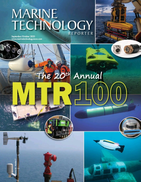Ocean Influencer: Mike Read, Teledyne Marine
Greg Trauthwein
Teledyne Marine is no stranger to the MTR reader, a group of leading-edge marine and subsea technology companies that are part of Teledyne Technologies Inc. and a driver of consolidation in the subsea sector for more than a decade. At the helm sits Mike Read, President, who has held a steady hand over the evolution of Teledyne Marine, through market cycles up and down.
Through acquisitions and collaboration over the past 10 years, Teledyne Marine has evolved into an industry powerhouse, bringing imaging, instruments, interconnect, seismic and vehicle technology together, today encompassing 23 brands grouped in three integrated verticals run by 1,500 employees globally.
2020 is significant for the evolution of Teledyne Marine, as it marks the culmination of its five-year effort to create ‘one’ Teledyne Marine with a one common ERP system, one global sales and service team, and one common software platform – Teledyne Marine Software (TMS) – across its 23 brands. Read said “TMS is particularly strategic, enabling the Instruments and Imaging products to communicate seamlessly. You can imagine all of the different software packages; it was all over the map, which is understandable. Now we’re working towards all of these products communicating seamlessly, producing better data, and delivering a better user experience.”
The integration of Teledyne Marine into three verticals – the large interconnect business; instruments and imaging; and vehicles – is particularly timely as one of its largest customer segments, the offshore energy business, is enduring another slump, magnified by the COVID-19 pandemic, and oil majors and large engineering firms alike are streamlining operations and technologies to be profitable with a $40 price per barrel of oil. “All operational excellence metrics are now centralized,” said Read. “We’ve made Teledyne Marine stronger, focused on global service levels, with a robust development strategy on the product side. We’ve stopped a lot of small developments, instead focusing on ‘Top 10 New projects.’ We’re looking forward to the remainder of this year, and the next five years where hopefully pandemics are not on the menu.”
People to People
While companies like Teledyne Marine are geared toward the creation of products and systems that help make the ‘dull, dirty, dangerous’ jobs safer and more efficient, ultimately it is a people business. “As effective as Zoom and Webex can been, there’s no doubt that this is a people to people business,” said Read. “We like to have our customers come in to brainstorm with our people, and our customers like to come here with their problems. In addition, we manufacture a large amount of hardware every year, so our production people have to come to work. But it’s always safety first; and (with the advent of COVID-19) we’ve been able to make our facilities even safer.”
Looking ahead, Read sees ample opportunity; “In each of the markets we serve there’s a little bit of good news.”
In Read’s estimation, the first bit of good news for Teledyne Marine is that it’s part of Teledyne Technologies, “a diverse company that has acquired more than 65 companies over the last 20 years. Our parent company is very diverse; we are strong as a company,” said Read. “At the marine level, we have a strong offshore energy business (providing) the majority of the electrical & optical interconnect to the sector. We are the market leaders.”
On the military side, Read said the company is fortunate that there are a lot of subsea defense applications, led by the U.S. Navy, whether it’s building nuclear submarines, whether it’s building mine countermeasure vessels, whether for the U.S. Coast Guard or for foreign navies. “That market today is more active than it ever has been.” He said the advantage of the integration of Teledyne Marine into ‘one’ is particularly clear on the military side, as it is able to offer bundled packages – from Gavia AUV’s, to Seabotix ROVs, to multibeam sonar on the ship itself, for example. “We do that now with one Teledyne Marine, and we could not have done that five years ago as a wholistic opportunity.”
Looking for new opportunities, the company recently entered the marine construction sector. Business opportunities in dredging, as harbors deepen for ever larger ships; and in the business of clearing harbors for the decommissioning of old and construction of new bridges is vibrant and growing.
Read adds, “We continue to package and align our technologies for new and exciting emerging markets. As experts in real-time underwater vision, we’re combining our technologies and partnering with organizations such as Trimble and DSC Dredge to provide operators of heavy machinery on barges and dredges with tools to improve their efficiency and effectiveness.”
Challenges Ahead
Challenges abound for any leader in any industry, and when Read surveys the landscape of the markets his company serves, he still sees the need for the implementation of technology solutions to remove the human element from particularly dangerous situations previously the province of divers. In addition, he personally has been leading the charge to push for increased standardization throughout the product sectors, believing that a pervasive $40 per barrel oil price will help in this regard. He gives an example: “Instead of 800 variants of four-way electrical flying leads, you can get it down to 10, and that will help to take cost out,” he said. Summarize, Read said “we love challenges, for example the challenge to make materials last 30 years underwater; that is our sweet spot, that’s our niche. We have a materials database in Teledyne Scientific for the last 10 years which proves the reliability of the materials chosen. It’s unique, no one else has this. It’s important because the cost of failure is enormous.”
Teledyne Technology Report
Teledyne Marine is a group of leading-edge subsea technology companies that are part of Teledyne Technologies Inc. Through acquisitions and collaboration, it has evolved into a powerhouse, with a large breadth of technology, including: vehicles, instruments, imaging, interconnect and seismic solutions. Here are some latest technology advances:
Z-Boat 1800T, Trimble Edition
(Teledyne Oceanscience)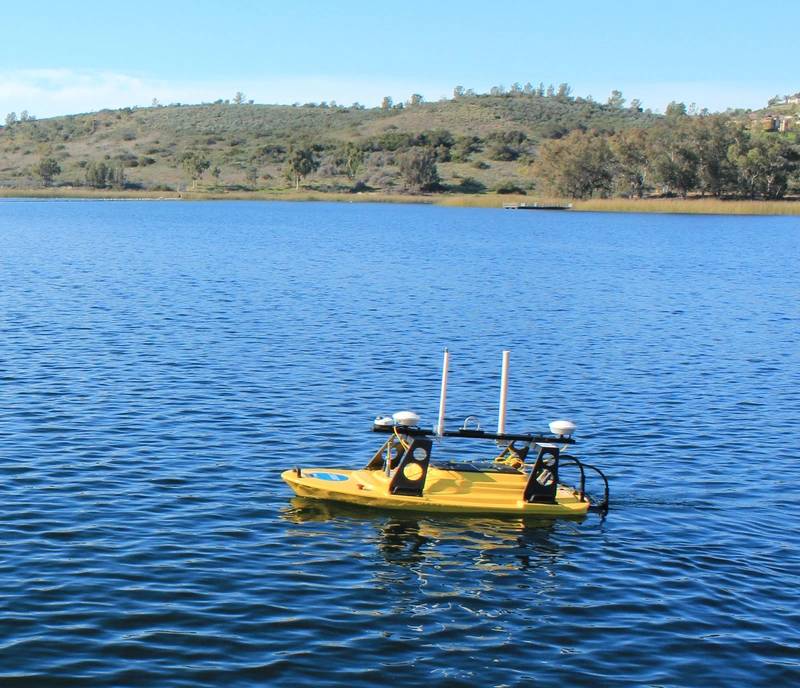 Teledyne Marine’s new Z-Boat 1800T ready for your next inspection or mapping project.The Z-BOAT 1800-T is a high-resolution shallow water hydrographic unmanned survey vehicle with an Odom Echotrac E20 Singlebeam Echosounder and dual antenna Trimble BX992 GNSS heading receiver. Each sensor is integrated into a compact, portable, and cost-effective package. The combination of Trimble’s precise heading and positioning/guidance paired with Teledyne’s accurate/precise sonars and rugged autonomous vehicle design, allow for best in class data collection under harsh conditions and is ideally suited for marine construction, dredging, and civil engineering tasks.
Teledyne Marine’s new Z-Boat 1800T ready for your next inspection or mapping project.The Z-BOAT 1800-T is a high-resolution shallow water hydrographic unmanned survey vehicle with an Odom Echotrac E20 Singlebeam Echosounder and dual antenna Trimble BX992 GNSS heading receiver. Each sensor is integrated into a compact, portable, and cost-effective package. The combination of Trimble’s precise heading and positioning/guidance paired with Teledyne’s accurate/precise sonars and rugged autonomous vehicle design, allow for best in class data collection under harsh conditions and is ideally suited for marine construction, dredging, and civil engineering tasks.
M-Series Mk2 2D Multibeam Imaging
(Teledyne Blueview)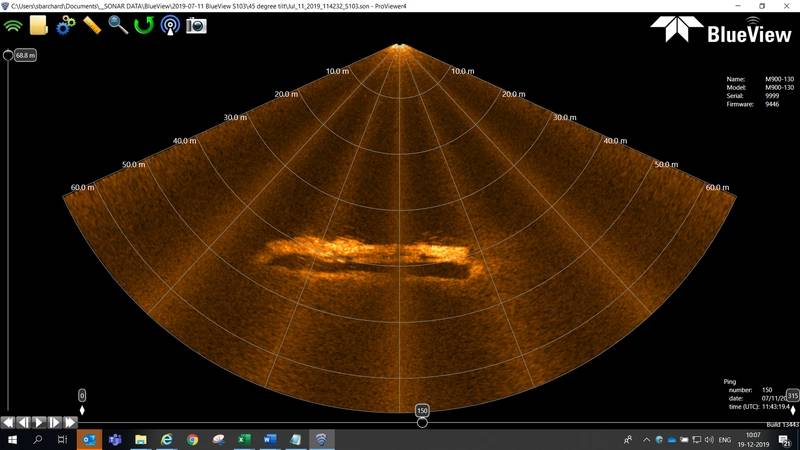 The M Series 2D multibeam imaging sonars deliver a compact form factor with low power requirements and unparalleled sonar image quality over a wide field of view. The new open nose cone design delivers optimal acoustic performance for increased image quality and improved range performance. All M Series sonars operate while in motion or from a stationary position, delivering real-time imagery and data. This product is ideally suited for diver platforms for search and recovery or ROVs for object detection and obstacle avoidance, as well as near field high-resolution object identification.
The M Series 2D multibeam imaging sonars deliver a compact form factor with low power requirements and unparalleled sonar image quality over a wide field of view. The new open nose cone design delivers optimal acoustic performance for increased image quality and improved range performance. All M Series sonars operate while in motion or from a stationary position, delivering real-time imagery and data. This product is ideally suited for diver platforms for search and recovery or ROVs for object detection and obstacle avoidance, as well as near field high-resolution object identification.
Tasman DVL
(RD Instruments)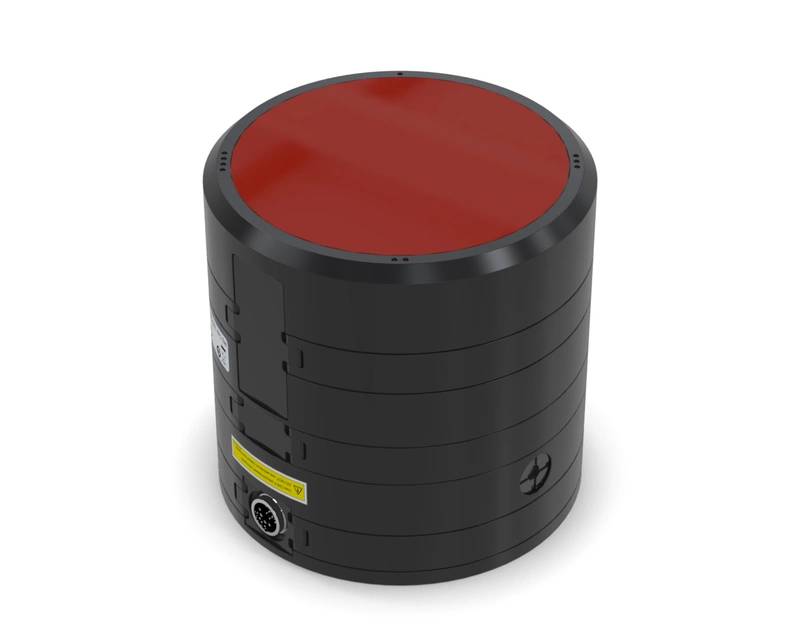 Teledyne RDI Tasman DVL.The Tasman DVL, with its array of features, reduced size and increased range, is becoming the new standard in Doppler navigation technology. With bottom-tracking ranges from 0.15 m to 400 m in up to 6,000 m water depths, the Tasman is versatile enough to navigate small ROVs to large diameter AUVs. Key advancements include field-swappable phased array transducers, system health monitoring/leak detection, ethernet compatibility, and the ability to upgrade to collect ADCP data.
Teledyne RDI Tasman DVL.The Tasman DVL, with its array of features, reduced size and increased range, is becoming the new standard in Doppler navigation technology. With bottom-tracking ranges from 0.15 m to 400 m in up to 6,000 m water depths, the Tasman is versatile enough to navigate small ROVs to large diameter AUVs. Key advancements include field-swappable phased array transducers, system health monitoring/leak detection, ethernet compatibility, and the ability to upgrade to collect ADCP data.
HydroPACT 660E
(Teledyne TSS)
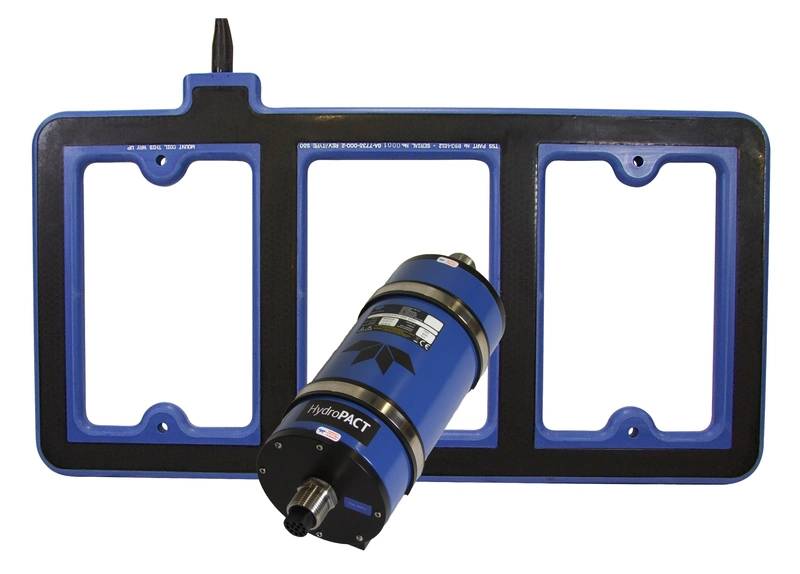 Teledyne TSS HydroPACT 660E Single pod and coil.The HydroPACT 660E brings pipe tracking and UXO detection capabilities to small inspection and observation class ROVs, for applications that were previously only available on larger vehicles such as work class ROVs and trenchers. The single smaller pod reduces the installed footprint and payload of the system while maintaining an operating range of greater than 85% of that of the larger HydroPACT 440 system. The coil array features an integrated cable for even greater reliability and is very well-suited to smaller ROVs, offering users the opportunity to reduce their operating costs on future projects.
Teledyne TSS HydroPACT 660E Single pod and coil.The HydroPACT 660E brings pipe tracking and UXO detection capabilities to small inspection and observation class ROVs, for applications that were previously only available on larger vehicles such as work class ROVs and trenchers. The single smaller pod reduces the installed footprint and payload of the system while maintaining an operating range of greater than 85% of that of the larger HydroPACT 440 system. The coil array features an integrated cable for even greater reliability and is very well-suited to smaller ROVs, offering users the opportunity to reduce their operating costs on future projects.
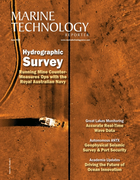
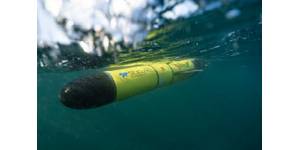
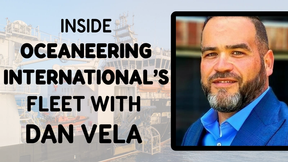
 August 2025
August 2025


